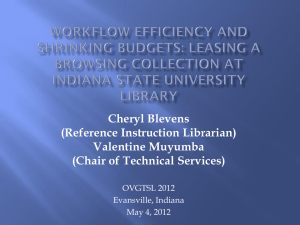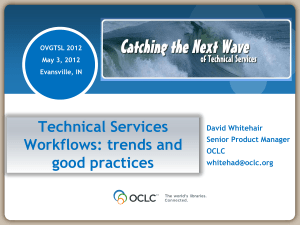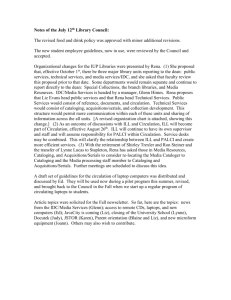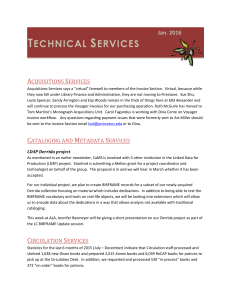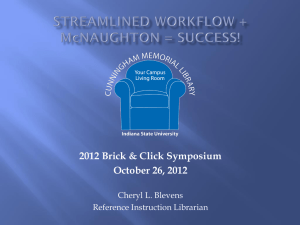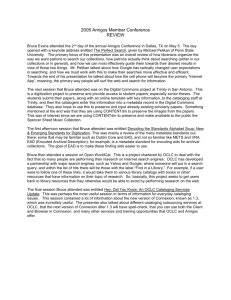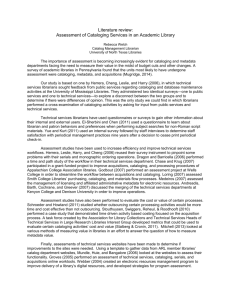The Minimal Level Task Force
advertisement
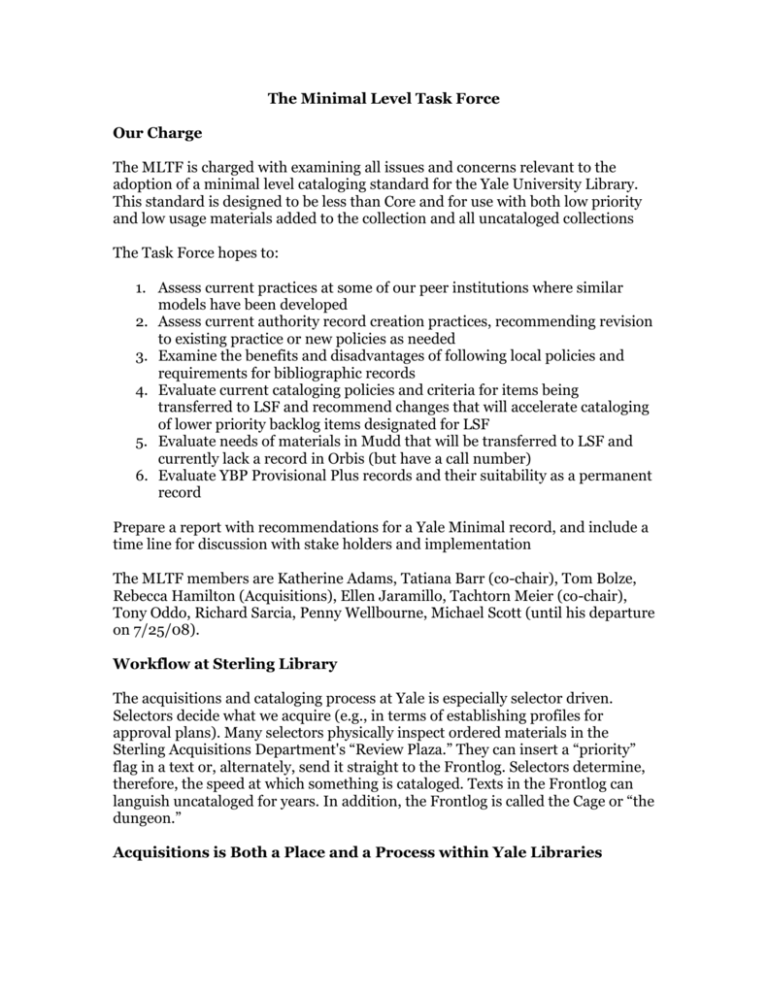
The Minimal Level Task Force Our Charge The MLTF is charged with examining all issues and concerns relevant to the adoption of a minimal level cataloging standard for the Yale University Library. This standard is designed to be less than Core and for use with both low priority and low usage materials added to the collection and all uncataloged collections The Task Force hopes to: 1. Assess current practices at some of our peer institutions where similar models have been developed 2. Assess current authority record creation practices, recommending revision to existing practice or new policies as needed 3. Examine the benefits and disadvantages of following local policies and requirements for bibliographic records 4. Evaluate current cataloging policies and criteria for items being transferred to LSF and recommend changes that will accelerate cataloging of lower priority backlog items designated for LSF 5. Evaluate needs of materials in Mudd that will be transferred to LSF and currently lack a record in Orbis (but have a call number) 6. Evaluate YBP Provisional Plus records and their suitability as a permanent record Prepare a report with recommendations for a Yale Minimal record, and include a time line for discussion with stake holders and implementation The MLTF members are Katherine Adams, Tatiana Barr (co-chair), Tom Bolze, Rebecca Hamilton (Acquisitions), Ellen Jaramillo, Tachtorn Meier (co-chair), Tony Oddo, Richard Sarcia, Penny Wellbourne, Michael Scott (until his departure on 7/25/08). Workflow at Sterling Library The acquisitions and cataloging process at Yale is especially selector driven. Selectors decide what we acquire (e.g., in terms of establishing profiles for approval plans). Many selectors physically inspect ordered materials in the Sterling Acquisitions Department's “Review Plaza.” They can insert a “priority” flag in a text or, alternately, send it straight to the Frontlog. Selectors determine, therefore, the speed at which something is cataloged. Texts in the Frontlog can languish uncataloged for years. In addition, the Frontlog is called the Cage or “the dungeon.” Acquisitions is Both a Place and a Process within Yale Libraries The Acquisitions Dept. is located across the hall from CMS, but acquiring library resources is a fragmented process that occurs across the Yale library system. Various selectors and libraries on campus order material. One key task of the Acquisitions Dept. is feeding material to the A&S and the HSS Teams. However, not all materials that come to the CMS Dept. arrive there through the Sterling's Acquisitions Dept. For example, acquisitions procedures are carried out by the Latin American selector's office, and it delivers items to CMS for cataloging. Rare materials are given, in a similar fashion, to the Rare Book team from the Acquisitions dept. at the Beinecke Library. Slavic, Hebraic,and African Studies materials are also not processed by Acquisitions. Materials for the East Asia and South East Asia collections have their own acquisitions and cataloging units within Sterling. By contrast, the British Art Center and the Divinity School Library maintain independent, off-site technical service units. Items are Ordered by the Sterling Acquisitions Dept. in Five Ways: 1. 2. 3. 4. 5. Blanket order/ Approval plans (i.e., materials sent to us via profiles) Standing order (e.g., series) Firm order (i.e., a specific request for a title) Gifts (if the selector approves) Exchanges with non-U.S. institutions What Happens When Materials Come to Live at Sterling? Except for Rare Book materials that come from the the Beinecke, there is an acquisitions-level record in Orbis for every ordered item. What occurs next is a complicated story. We have created two Visio diagrams to help you keep events straight. PDF links: http://www.library.yale.edu/cataloging/Acquisitions_Workflows.pdf http://www.library.yale.edu/cataloging/Overview_Workflow.pdf An overview of Sterling's Acquisition process is available and a diagram of the decision tree that informs these procedures is available below. We obtain catalog records in a number of ways: vendors sell them to us; we locate LC or PCC records in OCLC; we create original cataloging records (from full to core level); and some items are sent straight to the Frontlog without searching in OCLC for copy. There are, in general, three cataloging workflow patterns at Sterling: 1. Materials go straight to Preparations or the Stacks: If LC is involved somewhere in the cataloging process or if a vendor provides LC-style cataloging service, items are eligible for Fast Cat treatment by the Acquisitions Dept. and bypass CMS altogether. For instance, Acquisitions staff may locate an LC record when the item arrives. Harrassowitz contracts with MarcNow and offers full cataloging records. Casalini offers roughly the same product, and a few titles are termed “shelf-ready” and arrive fully processed. 2. Materials go to the CMS Department: Items are transferred to CMS for a vareity of reasons. If items have PC copy or a selector marks something as “Priority.” (e.g., red flags for Rush items, yellow flags for High Visibility titles). Outside libraries and/or selectors deliver material to us. When items meet certain criteria (e.g., NJ18, "P" classification, new serials, multi-part materials), they are shipped to CMS regardless of the presence/absence of copy. 3. Materials go to the Frontlog (i.e., the Cage): Materials are banished to the basement in the absence of available copy or by selector mandate. In addition, non-English books from some selectors that don't have vendor supplied records, go straight to the Frontlog. Acquisitions staff does not search OCLC for these materials because the hit rate is so low. (This can help explain why there are so many non-English language materials in the Frontlog) Area Studies Teams: Latin America, Slavic, Hebraic, African Materials In rough terms, its all the same model. Stuff comes into the Slavic Reading Room, for instance, and goes to the Slavic team for cataloging or down to the Cage. When an item is transferred to the Frontlog or to a team for cataloging, a provisional or OCLC record accompanies the material. Frontlogs and Backlogs: Uncataloged Materials The Frontlog is stuff we have not cataloged. There is no conceptual distinction between the Frontlog and the backlog in that all these materials are uncataloged. There is a small differentiation between Frontlog and backlog materials, however: an item in the backlog by local definition has been searched against the OCLC database at least once. The backlog is composed of uncataloged stuff, but we've made an effort to locate copy. The Frontlog rests undisturbed, and is, said otherwise, an unsearched backlog. The Frontlog is both a Place and a State of Being The Frontlog is a place located in the basement (take the stairs next to the elevator), and this term defines library items that have not been queried in the OCLC database. The Frontlog is in a locked cage. The keys to the Cage are located in various places. 1. Dora's desk. The key ring is a blue tennis racket with two keys. Use the little key. 2. Under the window in the SSH Team there are keys in a box, and there's a set of keys across from Joan Hunt's desk The locked Cage and the Frontlog are not identical. The Frontlog is composed of materials that have not been searched, and these items can be held anywhere in the library. The A&S and HSS Teams have their frontlogs in this cage, but this area includes a lot of other material such as, yes, team backlogs! This can understandably lead to confusion for the uninitiated. Just remember the distinction between Frontlog as place and Frontlog as a mode of (un)cataloging (or state of bibliographic unbeing). In Relative Terms, how Many Uncataloged Items are There? Yale receives 160,000-200,000 titles per year, and this is, roughly, the number of items that are uncataloged in Sterling. While some would characterize this as “not keeping up” with our cataloging workload, the manager of the Frontlog disagrees and points out that the number of uncataloged materials is declining. By Location/Team No. of Vols., 03/2008 No. of Vols., 07/2007 Vault (aka Old Zeta) 3500 3500 Pamphlets 4800 4500 Pre-1981, General Backlog 1400 1390 1982-1992, General Backlog 1400 1490 Room 3 38,571 38,997 Frontlog 92,000 78,000 Slavic 14,000 16,000 Hebraic 15,000 15,000 In Process (w/in our dept.) 10,000 10,000 Total in all Locations 200,000 220,000 How is the Cage Organized? The Frontlog is ordered by Uncat Numbers only. Acquisitions will insert a white flag with an Uncat number into every item sent to the Frontlog. Backlogs are, generally speaking, divided by teams and then subordered by Date Groups. Date Groups are composed of two variables. 1. A pseudo-patron number An item is "charged" to a patron. (Don't be confused! Books in the Frontlog have pseudo-patron numbers but these items are not organized by pseudo-patron numbers.) 2. A charge date Within a specific pseudo-patron account, the books are further identified by charge date. ¿Is there a hitch? Of course! These materials may have an Uncat number. This is on the usual white slip of paper, but not all Backlog books have an Uncat Number. Uncat Numbers were instituted only 10 years ago. Backlogs and Room 3 There are backlogs all around us! For instance, each team and often each cataloger has a backlog in her/his work space. “Room 3” is the back room of the locked Cage and consists primarily of backlog materials. (In addition, Room 3 includes gifts, Hebraic materials, etc.) This room holds materials that have been “re-searched” against OCLC and LC for copy. Good copy in this case is defined as what “could be easily cataloged by a cataloging assistant,” by the Frontlog manager. This search process is (largely) automated and occurs in two ways: 1. Internal to the Yale Library System, we match ISBN numbers from bib records for frontlog materials with a copy of the LC database that's locally maintained (i.e., the LCDB). This occurs once per month. 2. OCLC matches our records against their database-theoretically. This may occur twice a year, but Yale has run the match once in three years. This could yield PC copy. OCLC has a more sophisticated algorithm than matching by ISBN What is the Vault (aka Old Zeta), Where is it and How do I Get There? Go to Microfilm reader and take the stairs down to the basement. Keys to this space are found in two locations. There is a key on Dora's desk with a keychain that reads “Zeta.” In addition, you can find a key across from Joan Hunt's desk. The door to the Vault automatically locks, so beware. This is a swamp. Rain boots are recommended. It is the dregs of the library and includes a large undifferentiated backlog of pre-1980s materials. There are old art auction catalogs, microfilm of Yale dissertations and an Arts and Sciences Team backlog. There are about 3,000 plus items.
